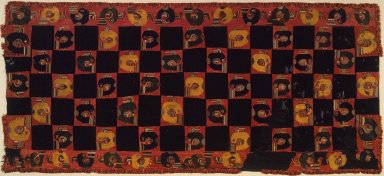
Artist:NascaParacas Necropolis
Medium: Cotton, camelid fiber
Geograhical Locations:
Dates:0–100 C.E.
Dimensions: 117 11/16 x 53 15/16 in. (298.9 x 137 cm)
Collections:
Accession Number: 34.1558
Image: 34.1558.jpg,
Catalogue Description: This mantle would have been used by an adult male, as clothing or for ceremonial purposes, or for both. The dark blue plain weave field is composed of a horizontal camelid fiber warp and camelid fiber weft. The border is a horizontal cotton warp, with a cotton weft. Camelid fiber one-faced stem stitch curvilinear embroidery in dark blue, yellow, and green, brown, white, red, pink and yellow green is used to represent turning falcons that appear on the red border and the field. A band of one-faced cross looping extends around the outer edge of the border and the fringe (NK). There are 37 field figures and 31 border figures (one figure is missing in the border). From Mary Frame's notes: Although there is a 38cm area missing from one border, the color and symmetry pattern indicate only one figure is missing. There would have been 15 figures on each border originally, for a total of 69. There are two orientations in the borders and three in the field, including one aberrant orientation. Two figures in the bracket ends of the borders do not fit with the border alternation; two field figures between the brackets do not fit with the field alternation. The border with the missing section was probably slightly shorter than the field, just as the other border is. There are three variants of bird figures executed in dark blue, yellow and dark green. Two figures in the bracket ends of the borders do not fit with the border alternation; two field figures between the brackets do not fit with the field alteration. The eye, breast, wing and tail markings, which are rendered in precise details, are usual falcon attributes. The raptors are represented with backward bent necks, in a backward bent posture. From a wider study of the iconography, I suspect the back bent posture is associated with sacrifice and prey. A forward bent posture is usually associated with sacrificers and predators. Figures with falcon attributes are numerous among the embroideries and they usually appear to be at different stages in the transformation from mythical human to falcon. Conceivably, a falcon figure such as the one represented on this mantle might represent the end point in a transformation continuum. A small number of birds are shown with backward bent necks: BM 86.224.95 (ponchito) and TM 91.126 (border) show birds, possibly hawks or falcons, with necks bent so the head is entirely inverted. Other birds (MMS 33.149.102) and figures transforming toward becoming falcons (Sailor #10) also occur in a backward bent posture.